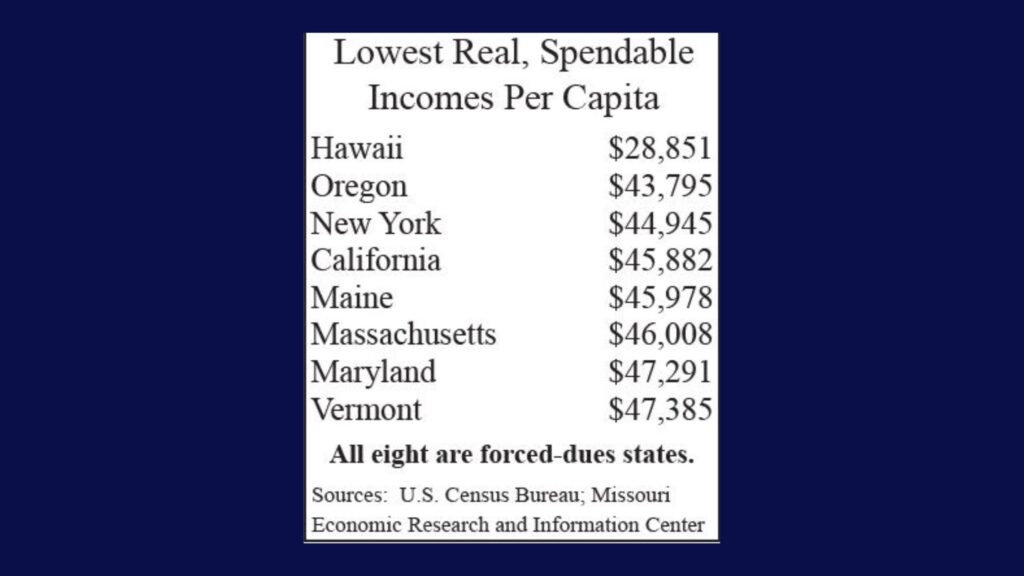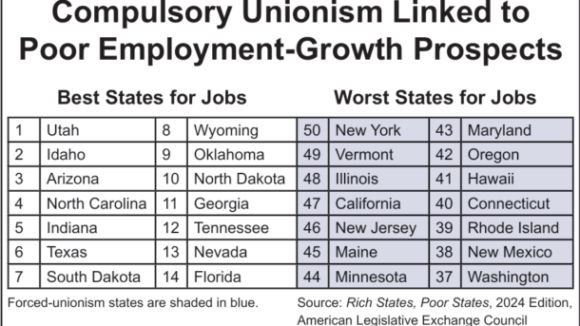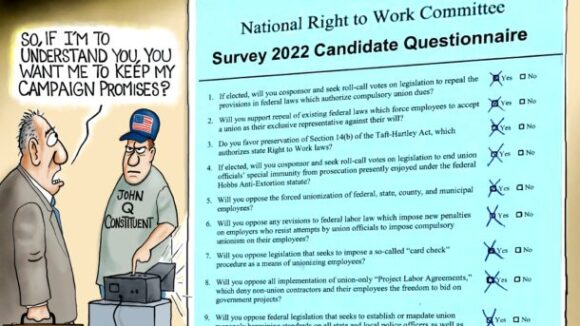Is This Any Way to Run a City’s Schools?
Leaked CTU Proposals Won’t Do Anything to Improve Schools’ Poor Performance

In March 2021, using the COVID-19 pandemic as an excuse, a Big Labor Congress rubber-stamped, and union-label President Joe Biden signed into law, an omnibus spending bill including roughly $500 billion for government K-12 schools and other state and local government agencies.
As the National Right to Work Committee charged at the time, this huge bailout was obviously designed to help union-boss puppet state and local politicians paper over huge fiscal shortfalls caused by Big Labor monopoly bargaining abuses, not COVID-19.
And it worked — briefly.
Unfortunately, as soon as their COVID transfer payments ebbed last year, politically powerful Big Labor strongholds New York, Illinois and California began suffering from declining overall income, as an October 5 Wall Street Journal editorial pointed out.
As the Journal editorial explained, union boss-dominated New York, Illinois and California used their COVID bailout money “largely to cover pre-existing budget shortfalls, boost government worker pay, and bake into their budget new spending obligations.”
Along with most other non-Right to Work states, they also took full advantage of extended and enhanced unemployment benefits financed primarily by federal taxpayers, long leaving millions of employees with little financial incentive to return to work after 2020’s COVID lockdowns.
The juiced-up government spending and transfer payments pumped up incomes in late 2020 and 2021, but their overall, longer-term impact has been to accelerate the exodus of job-creating-and-sustaining businesses out of forced-unionism states.
In sharp contrast, Right to Work states like Florida and Georgia spent their COVID funds on public-works projects that will furnish long-term benefits for their residents and businesses operating within their borders, even if political considerations have prevented the money from being ideally allocated.
Not surprisingly, while the 2022 declines in “federal transfer payments” to New York, Illinois and California exceeded their growth in “wages and business income,” the opposite was true in fast-growing Right to Work states like Florida, Arizona, Texas, Utah, South Dakota, Idaho, and North Dakota.
National Right to Work Committee Vice President Greg Mourad commented that the “pandemic hangovers” now darkening the fiscal outlooks for the states where politicians are most subservient to Big Labor are actually symptomatic of a chronic failure to create good-paying, family-supporting jobs.
“The fact is,” said Mr. Mourad, “paychecks in union-label states like New York and California don’t go as far as they do in Right to Work states, once cost of living is factored in.”
The same updated U.S. Commerce Department data cited by the Journal editorial show this is so.
Once adjusted for interstate cost-of-living differences according to an index calculated by the Missouri Economic Research and Information Center, a state government agency, the average after-tax income per person in Right to Work states in 2022 was $55,320. That’s roughly $3,700 higher than the forced-dues state average.
“The bottom line,” said Mr. Mourad, “is that families in Right to Work states typically have thousands of dollars more to spend each year than families located in forced-unionism states.
“Six of the eight states with the highest real, spendable incomes per capita are Right to Work.
“And the eight states with the lowest real, spendable incomes — Hawaii, Oregon, New York, California, Maine, Massachusetts, Maryland and Vermont – are all forced-unionism.
“No one should be surprised that union coercion hurts workers, along with small business owners, taxpayers and retirees.”
Mr. Mourad elaborated: “The forced-union-dues system foments hate-the-boss class warfare in many workplaces.
“And it helps Big Labor officials impose and perpetuate counterproductive work rules.”
This article was originally published in our monthly newsletter. Go here to access previous newsletter posts.
To support our cause and help end forced unionism, go here to donate.

Leaked CTU Proposals Won’t Do Anything to Improve Schools’ Poor Performance

Wherever Big Labor wields the power to collect forced union dues, union bosses funnel a large share of the confiscated money into efforts to elect and reelect business-bashing politicians. Employment growth tends to lag as a consequence.

Members Insist They Keep Pro-Right to Work Campaign Promises